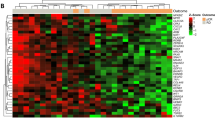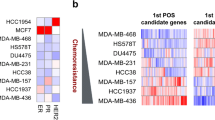Summary
Introduction
Doxorubicin and cyclophosphamide (Adriamycin/cytoxan, AC) is a standard chemotherapy regimen for breast cancer, but de novo resistance is frequent. We hypothesized that gene expression profiles predictive of AC response may be different from our previously published patterns with docetaxel.
Methods
Core biopsies from 40 patients were obtained before treatment with AC (6 cycles, 60/600 mg/m2q3 weeks), and clinical responses recorded after treatment. Gene expression patterns were analyzed using Affymetrix U133A chips which comprise ~22,200 genes.
Results
Clinical complete responses (cCR) were observed in 22, partial responses in 7, stable disease in 11 patients. Differential expression between sensitive cCR and resistant tumors with a low false discovery rate (<5%) was obtained. Of these 253 differentially expressed genes, pathways up-regulated in sensitive tumors included cell cycle (BUB3, CDKN1B), survival (BCL2, BAG1, BIRC1, STK39), stress response (CYP2B6, MAPK14), and estrogen-related pathways (ER, IRS1). Resistant tumors expressed gene promoting transcription (GTF3C1, ILF3), differentiation (ST14, CTNNBIP1), signal transduction (EIF1AX, EIF4EBP1), and amino acid metabolism (SRM, PLOD1, PLOD3). With leave-one-out cross validation, 67% of the samples were correctly classified, with a permutation p-value of 0.4. The previously published 92-gene molecular portrait for docetaxel sensitivity could not discriminate AC sensitivity and resistance.
Conclusions
This preliminary study supports that molecular profiles for AC response are likely to exist, with unique expression patterns for individual chemotherapy regimens. Larger validation studies are necessary to define and refine patterns for different agents.
Similar content being viewed by others
References
The Early Breast Cancer Trialists’ Collaborative Group E, Tamoxifen for early breast cancer: an overview of the randomised trials Lancet 351:1451–1467 1998
EBCTG, Polychemotherapy for early breast cancer: an overview of the randomised trials Lancet 352:930–942 1998
Fisher B, Mamounas EP, Preoperative chemotherapy: a model for studying the biology and therapy of primary breast cancer J Clin Oncol 13:537–540 1998
Fisher B, Bryant J, Wolmark N, et al. Effect of preoperative chemotherapy on the outcome of women with operable breast cancer J Clin Oncol 16:2672–2685 1998
Chang J, Powles TJ, Allred DC, et al. Biologic markers as predictors of clinical outcome from systemic therapy for primary operable breast cancer J Clin Oncol 17:3058–3063 1999
Chang JC, Wooten EC, Tsimelzon A, et al. Gene expression profiling predicts therapeutic response to docetaxel (Taxotere(tm)) in breast cancer patients Lancet 362:280–287 2003
Schadt EE, Li C, Wong WH, Analyzing high-density oligonucleotide gene expression array data J Cell Biochem 80:192–202 2001
Radmacher MD, McShane LM, Simon R, A paradigm for class prediction using gene expression profiles J Comput Biol 9:505–511 2002
Mamounas EP, Preoperative doxorubicin plus cyclophosphamide followed by preoperative or postoperative docetaxel Oncology 11:37–40 1997
Ayers M, Symmans WF, Stec J, et al. Gene expression profiles predict complete pathologic response to neoadjuvant paclitaxel and fluorouracil, doxorubicin, and cyclophosphamide chemotherapy in breast cancer J Clin Oncol 22:2284–2293 2004
Acknowledgements
This study is supported in part by Breast Cancer Research Foundation, the Emma Jacobs Clinical Breast Cancer Fund, and the Breast Cancer SPORE, P50 CA50183 from the National Cancer Institute. Role of Funding Sources: The study sponsors did not contribute to the study design, collection, analysis, and interpretation of data.
Author information
Authors and Affiliations
Corresponding author
Additional information
Address for offprints and correspondence: Jenny Chang, Breast Center, Baylor College of Medicine, 1 Baylor Plaza, MS 600, Houston, TX 77030, USA; Tel.: +1-713-798-1905; Fax: +1-713-798-1642; E-mail: jcchang@breastcenter.tmc.edu
Rights and permissions
About this article
Cite this article
Cleator, S., Tsimelzon, A., Ashworth, A. et al. Gene expression patterns for doxorubicin (Adriamycin) and cyclophosphamide (Cytoxan) (AC) response and resistance. Breast Cancer Res Treat 95, 229–233 (2006). https://doi.org/10.1007/s10549-005-9009-7
Published:
Issue Date:
DOI: https://doi.org/10.1007/s10549-005-9009-7




